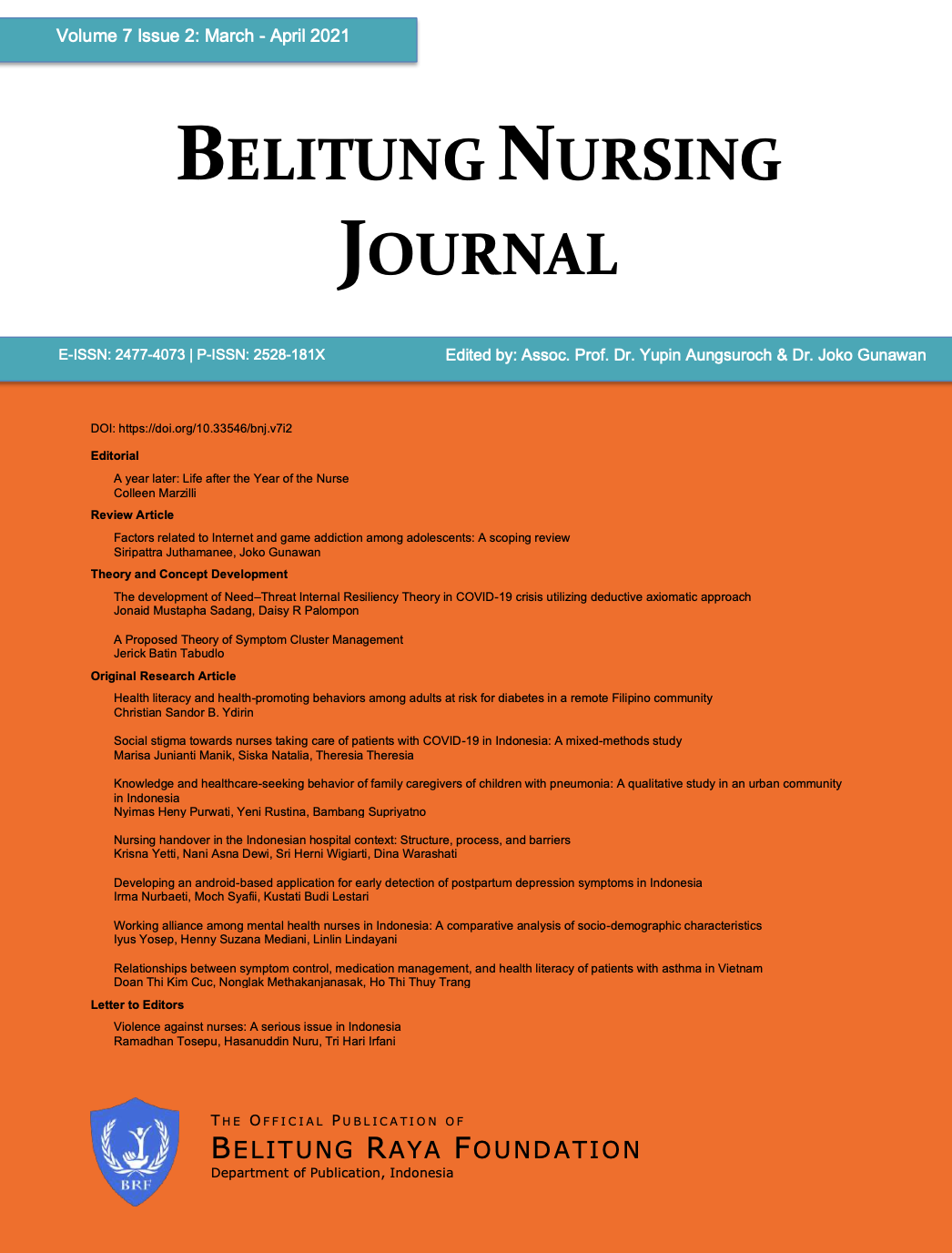Nursing handover plays a vital role in patient care continuity to ensure the quality of care and patients’ safety (Australian Commission on Safety and Quality in Healthcare, 2011). Handover is a routine process that usually occurs two to three times a day in most hospitals (Chaboyer et al., 2010; Mcmurray et al., 2011). It is designed for transferring care, including information about the patient’s condition, treatment plan, and intervention priority (Kilic et al., 2017). According to the national hospital accreditation standards in 2018, handover is one way to improve the patient’s safety. Thus, health care professionals need to increase effective communication. Joint Commission International (JCI) recommends developing and implementing handover processes among health care professionals (Hospital Accreditation Commission, 2017). However, on some occasions, due to the high workload, the handover process becomes a burden for nurses, which leads to the miscommunication of the patients’ care (Spooner et al., 2018). Therefore, effective communication is essential to provide accurate and complete information and avoid unexpected outcomes (Spooner et al., 2018).
There are four critical indicators considered on an excellent handover process in many Indonesian hospitals: timeliness, communication patterns, SBAR (situation, background, assessment, recommendations), leadership, and documentation (Herawati et al., 2018; Tobiano et al., 2018). These four things are assessed every month and recapitulated by the nursing department for monitoring and evaluation. SBAR technique has helped nurses to interact in a centered and easy manner during the transition of treatment (Achrekar et al., 2016). This model of interaction has gained popularity in healthcare settings, especially among professionals like the nursing staff. It is a way to communicate easily with each other for health care professionals and allows for efficient sharing of important information. Using standardized SBAR for bedside change handover in nursing practice would improve communication between nurses and ensure patient safety (Achrekar et al., 2016). SBAR format allows for the quick, structured, and consistent stream of professional knowledge (Thomas et al., 2009). SBAR technique’s primary purpose is to improve interaction efficiency by standardizing the communication system. Although handover is a common issue, the information about implementation and evaluation is limited. Therefore, this study aimed to describe the structure, process, and barrier of nursing handover in the Indonesian hospital context.
Methods
Study Design
This study employed a case study design in five inpatient units, especially in the medical-surgical wards of a referral hospital in Indonesia. The case study was chosen as an appropriate methodological approach to conduct an active investigation limited by place and time (Yin, 2003). In the case study, we asked questions about what, why, and how to analyze current, real-life situations with all their complexity (Kyburz-Graber, 2004).
Participants
The study was carried out on adults’ medical-surgical wards for neurological, oncology, and general surgical cases from August to November 2018. Each unit mainly consisted of four to six beds. A team and primary nursing were used as nursing care delivery models. Each unit has one team led by one head nurse, primary and associate nurses. This study participants were nurse managers, nursing staff, team leaders (those in charge of patient groups and nursing staff), and shift coordinators (who took overall responsibility for the ward operations).
Data Collection
This study used two data collection forms; observation and semi-structured focus group discussion (FGD). Due to reduced personnel during handover periods, we only included afternoon shift-to-shift handover, but the FGDs included all nursing staff, nurse team leaders, and nursing managers. We conducted observations guided by a data collection form. We recorded the handover process, including a number of the nurses in and out, the content of the information covered situation, background, assessment, and recommendations (SBAR) (Haig et al., 2006). When nurses asked questions or made statements about the current conditions in the handover process, they were deemed to be actively involved in the handover process. We were not considering passive participants if they only made insignificant comments like just say ‘OK’. Nurses were deemed not to be involved in the handover when there was no contact between nurses during the handover.
The participants were selected using a purposive sampling that involved nursing staff, nursing managers, and nurses team leaders. The focus group discussion was divided into five groups (one group from each ward). Questions were about structure, process, and barriers related to the handover, such as “how do you prepare handover?”, “What do you do in the handover process?”, and continued until there was no more new information.
Data Analysis
Data were analyzed through iterative review by all the research team members, which recursively examined the interview data, searching for similarities in the views of respondents and across the six cases using constant comparison. Similar ideas were then organized into categories of structures and processes. Structures involved physical and institutional properties, procedures done, and the results achieved. Assessing the quality of the handover process was undertaken by appraising and linking structures and processes with outcomes, assuming that structures influence processes, affecting outcomes. A fishbone analysis including man, method, machine, material, money, and environment was used as a framework to obtain barriers of nursing during handover.
Trustworthiness
A different technique was used to ensure the trustworthiness of this study. Credibility was achieved through detailed group discussions. Reliability was gained through the separate analysis of the transcript by three co-authors. The team then confronted and discussed the findings before an agreement on code, category, sub-theme, and theme had been attained. Transferability was demonstrated using semi-structured FGD sessions to reflect differences in specific populations and the appropriate quotations collected.
Ethical Consideration
The studied hospital’s ethical committee has approved this study (No. DM 01.01 / VIII.2 / 1359/2019). Participants were informed that the collected information would be kept confidential. All participants were provided a written informed consent to participate in this study. They had the right to withdraw from the study at any time without giving reasons or any penalties.
Results
A total of 100 handovers process were observed in five wards, and 76 nurses were interviewed. The majority of interviewees were males, graduated with a bachelor degree with a professional program with age ranged from 25 to 55 years old. The majority of the participants had been working for more than two years. About 75% of nurses had sufficient knowledge about the shift handover process using situation, background, assessment, and recommendations (SBAR).
The results from the observation focused on addressing the handover process. The handover occurred in the nurse’s station, and the one who started to transfer information was the outgoing staff. Oncoming staff is a leader to document all information and write it in an official book. While each nurse made their notes about patients’ condition and treatment plan. The handover structures were generally occurred between the team, not as a whole of ward handover. Situation, background, assessment, and recommendations (SBAR) were used in varying degrees of handover ranged from 55% to 85%. The nurses also actively participated during the handover process, although some nurses were absent in the handover time. The time for handover in the afternoon usually started from 14:00 to 15:00 West Indonesian Time (WIB), and the night shift began at 20:30 until 21:00, and in the morning shift started from 7:00 to 08:00 clock. Approximately four to five people were present at the handover process, including the team leader of the outgoing shift and all three team members of the oncoming shift.
Figure 1 describes the handover process in the studied hospital. There were three stages in the handover process: before, during, and after. Before the handover, the off-going nurses in charge of providing direct care to patients were prepared some notes or documents to report. The unique thing is that they started the process by firstly praying according to each religion, and then, the head nurse opened and started the meeting. The first meeting discussed new importation or reminded something, such as hand hygiene technique or updated information related to nursing interventions. During the handover, the outgoing staff reports the patients’ current situation, treatment plan, and other issues. The content of handover varied according to nurses’ familiarity with the patients and their complexities. After the handover finished, the upcoming nurses discussed job allocation and prepared to do routine activities.
The results of focus group discussion were used to explore the barriers that commonly happened during handover. Figure 2 illustrates the fishbone analysis used to describe the barriers divided into manpower, material, money, method, environment, and machine. From the viewpoint of the human resources, the barriers included adherence of nurses in the handover process, lack of mentoring from head nurses, and less participation. As stated by nurses in the FGD as follows: “… sometimes I was confused how to share the information because it’s a routine activity, and I know what I have to do even though I am an off-going nurse…” AND “…I listen to the information only from the outgoing nurses, especially the instruction from the medical doctor or others.”
From the material point, there was a guideline for supervision of handover. But the documentation using SBAR was not well implemented due to the items were not completely clear. The nurses state this in FGD: “…I know SBAR, sometimes I wrote completely, sometimes not, it depends on the available time…” AND “…I don’t know whether what I wrote in documentation is correct or not, or follow the correct SBAR guideline.”
Furthermore, lack of reward and unsupported environment were the other barriers of nursing handover.
Discussion
Our study shows a complex nursing handover process that involved management policy, environmental, and human resources. We found that the majority of nurses had sufficient knowledge about SBAR. Although SBAR was recommended to use during handover, the comprehensive information and communication direction was unclear. SBAR is a rigid handover structure that could transfer information objectively in a standard format (Haig et al., 2006). Interestingly, although the nurses adopted SBAR, no updated guideline or standard operating procedure about the handover; therefore, it is essential to evaluate the implementation of the handover process using SBAR consistently. A previous study suggested that prioritizing transferred information is important to help oncoming nurses to get information quickly and minimize overload information and time-consuming during handover (Patterson, 2008). Also, less use of current technology was applied during handover. Consequently, the documentation process has become a burden due to the time-consuming to write a complete story of the patients. Policymakers may consider using technology to reduce the time for documentation.
In this study, nurses showed active participation during the handover process, including making a decision, although some nurses were absent. One of the problems from the managerial aspect was less supervision to monitor the quality of the handover process. Empowerment is required in nursing care to perform nursing care to achieve nursing goals by considering patient safety, using critical thinking skills, and making effective communication (Pulvirenti et al., 2014). All nurses need to share the knowledge about a patient during the handover period and at the same time know that the others do know it. During handover, nurses’ empowerment is crucial because good empowerment can help achieve the hospital’s goal to provide excellent service (Laschinger et al., 2014). A study suggested that top management is expected to have involvement and commitment to improving and facilitating handover according to standards (Barker & Ganti, 1980). Continuous education for nurses regarding handover is imperative to update the new information and maintain the process comprehensively and correctly.
Conclusion
In conclusion, this case study provided the process and structure of handover and barriers that commonly happened during handover. This information can be used as basic information to develop or update guidelines or standard operating procedures of the handover for comprehensive implementation. Importantly, policymakers need to design an effective system and environment to overcome problems in the handover, such as using electronic documentation, providing a complete sheet as a guideline for handover, providing rewards and adequate supervision. The development of continuous education programs for nurses is also needed to update the handover information and maintain handover quality.











